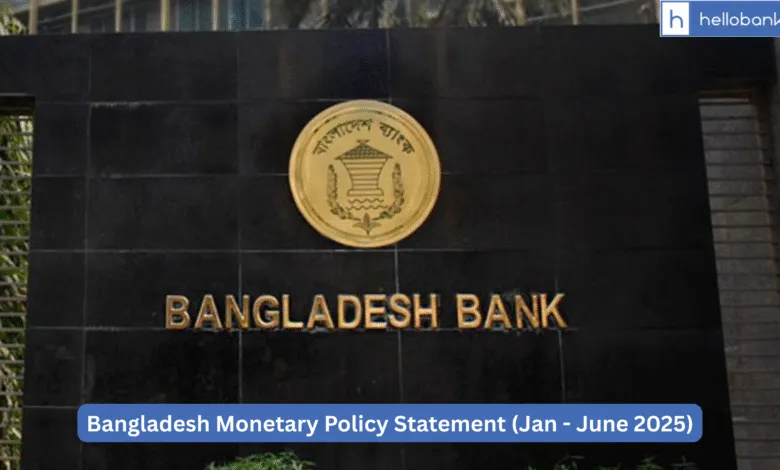Bangladesh Monetary Policy Statement (Jan – June 2025)

| Get instant news updates: Click here to join our Whatsapp Group |
Bangladesh Bank has released its Monetary Policy Statement for the period of January to June 2025. The report provides a clear picture of the country’s current economic condition and outlines the central bank’s plans for managing inflation, credit growth, and overall economic stability.
Download Report PDF (This Report is available for Premium Users Only. Click here to join premium)
Slowdown in Money Supply and Private Credit
In the first half of FY25, the growth of money supply remained subdued. One of the main reasons behind this was a slowdown in lending to the private sector. Private sector credit growth dropped to 7.3% in December 2024, the lowest rate since October 2021. In response to both domestic and international economic pressures, Bangladesh Bank has decided to continue with a tight monetary policy for the rest of FY25. This means controlling the flow of money in the economy in order to manage inflation, even if it results in slower economic growth temporarily.
Weak Economic Recovery and High Inflation
Bangladesh’s recovery from the COVID-19 pandemic has been slow. Real GDP growth was just 4.22% in FY24. At the same time, domestic inflation remained high. This challenging situation was caused by several global and local factors, including the prolonged Russia-Ukraine war, uncertainty in global markets, and rising inflation in major trading partners and countries that send remittances to Bangladesh.
Exchange Rate Pressures and Political Unrest
The slower economic performance was also influenced by changes in the exchange rate, which led to depreciation of the Bangladeshi Taka, a decrease in import demand, and strict monetary and fiscal policies. Additionally, political instability worsened the situation. Student-led protests in mid-2024 and the subsequent change in government caused uncertainty among both consumers and investors. As a result, real GDP growth dropped sharply to 1.81% in the first quarter of FY25, compared to 3.91% in the final quarter of FY24.
Growth Outlook for FY25 and Beyond
The economic outlook for the rest of FY25 remains weak, with growth likely to remain in the range of 4.0% to 5.0%. However, there are some positive signs that may provide short-term support to the economy. These include higher remittances from overseas workers, strong exports from the Ready-Made Garments (RMG) sector, and increased private spending ahead of upcoming religious festivals. Still, with the government focused on improving its finances and Bangladesh Bank continuing to fight inflation, a strong economic recovery is unlikely in the near term. The situation is expected to improve in FY26, with projected GDP growth returning to 6% or more, provided political conditions stabilize and economic policies become more supportive.
Rising Public Sector Borrowing
While bank deposits have not grown significantly, borrowing by the public sector increased sharply. In December 2024, credit to the public sector rose by 18.1%, which was well above the target of 14.2%. This increase was mainly due to the government’s need to fund its spending, especially as tax collections fell below expectations. Overall domestic credit growth exceeded targets, but much of this growth came from public sector borrowing. This limited the availability of credit for the private sector, a phenomenon known as “crowding out.”
Government’s Banking and Savings Strategy
Between July and December 2024, the government borrowed a net amount of Tk. 14,642.54 crore from the banking system. This represents 14.79% of its revised target of Tk. 99,000 crore in bank borrowing for FY25. Most of this borrowing came from scheduled banks (Tk. 69,056.1 crore), while the government repaid Tk. 54,413.6 crore to Bangladesh Bank. As Bangladesh Bank has stopped devolving government securities, the government is now mainly relying on scheduled banks for funding.
Decline in Savings Certificate and Foreign Financing
The government’s borrowing from National Savings Certificates (NSCs) also declined. During July to November of FY25, net NSC investments dropped by Tk. 15,588.6 crore. This is a larger decline compared to the same period in FY24, when the drop was only Tk. 5,539 crore. This shows that repayments were higher than new sales, possibly because people are shifting their savings to other investment options. Additionally, net foreign financing during the same period stood at Tk. 5,540 crore, which is Tk. 11,086 crore less than what was received during the same months in the previous fiscal year.
Download Report PDF (This Report is available for Premium Users Only. Click here to join premium)
